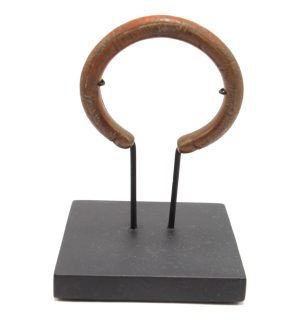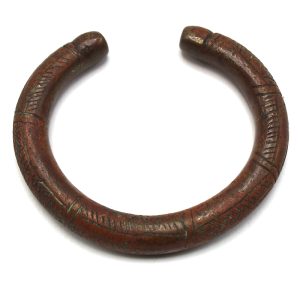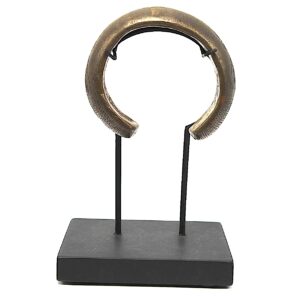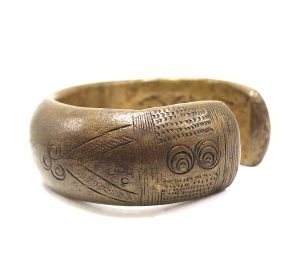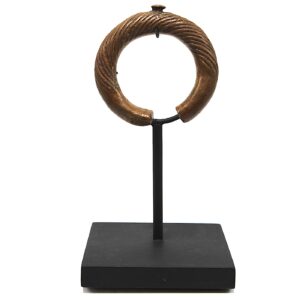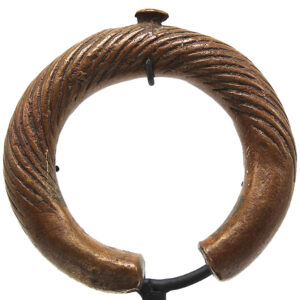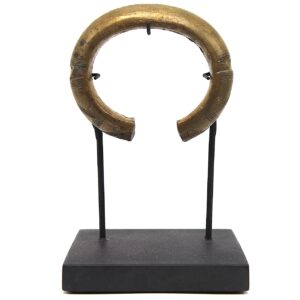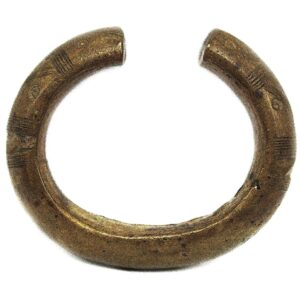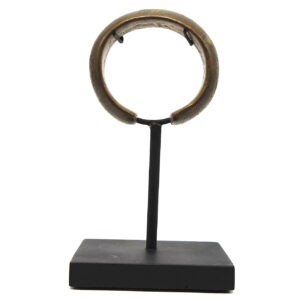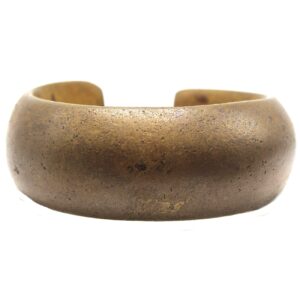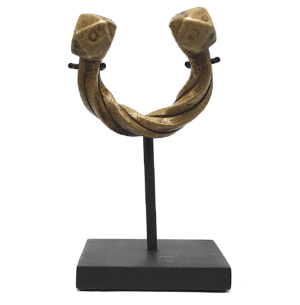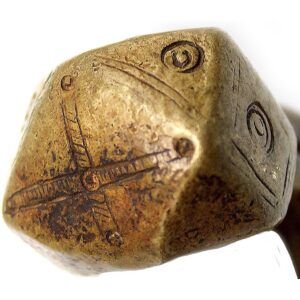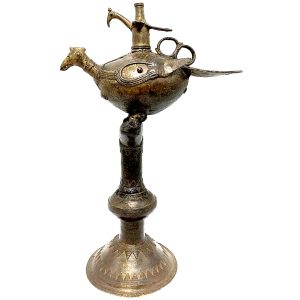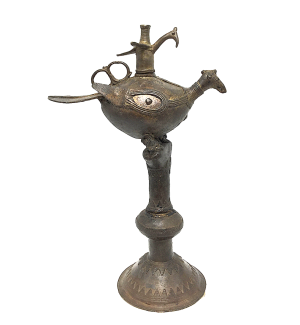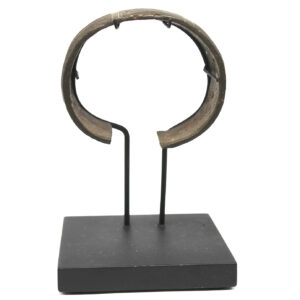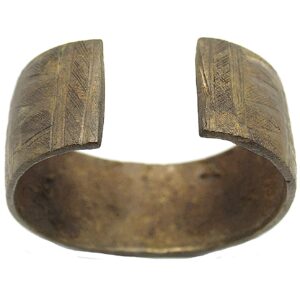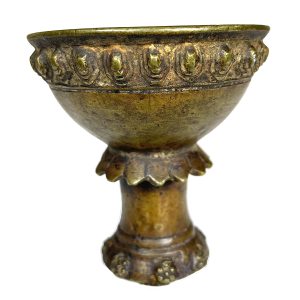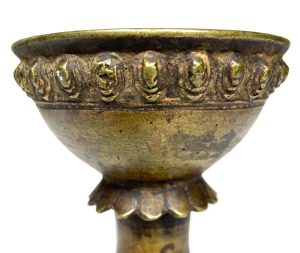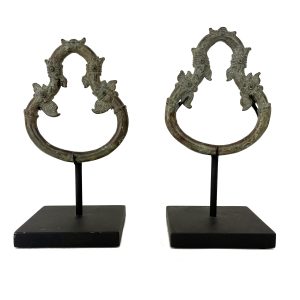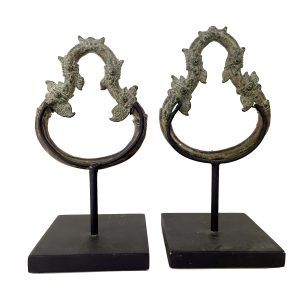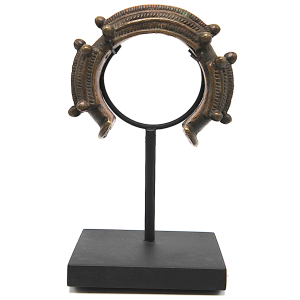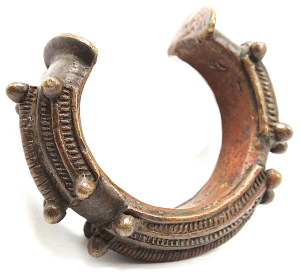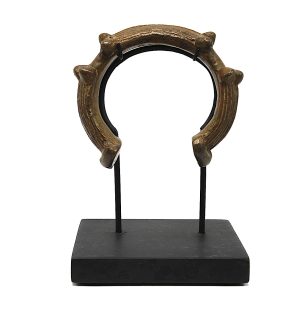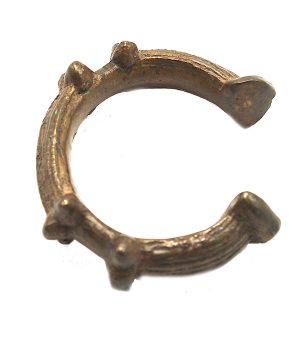Showing 13–24 of 48 results
-
Sale!


$110.00 Original price was: $110.00.$90.00Current price is: $90.00.
H: 2.75” W: 3.125” Thick: 0.375” Circum. 8.25” | FREE SHIPPING WITHIN CONTINENTAL U.S.
Antique Fulani manilla from Mali or Niger, thin C-shaped, rounded smooth surfaces inside divided into 6 sections with incised crosshatch and linear designs. Fine patina, excellent condition signs of use consistent with its age.
-
Sale!


$170.00 Original price was: $170.00.$145.00Current price is: $145.00.
H: 2.75” W: 3” Thick: 0.5” Circum: 8” | FREE SHIPPING WITHIN CONTINENTAL U.S.
Antique thick, rounded and smooth Fulani manilla etched with intricate geometric designs at the ends and apex.
-
Sale!


$165.00 Original price was: $165.00.$135.00Current price is: $135.00.
H: 2.875” W: 3” Thick: 0.625” Circum: 8.5” | FREE SHIPPING IN CONTINENTAL U.S.
Fine Fulani round manilla bracelet with parallel ridges over most of surface resembling a twisted metal pieces, topped with extended flat boss/knob in center.
-
Sale!


$185.00 Original price was: $185.00.$145.00Current price is: $145.00.
H: 2.75” W: 2.875” Thick: 0.5” Circum: 8.75” | FREE SHIPPING WITHIN CONTINENTAL U.S.
Antique thick metal manilla, smooth rounded outer surface with deeply etched and stamped traditional designs of triangles, horizontal bands, circles, facets and groves, flat ends. Excellent condition with fine patina.
-
Sale!


$195.00 Original price was: $195.00.$155.00Current price is: $155.00.
H: 2.625” W: 3” Thick: 0.25” Circum. 8.25” | FREE SHIPPING WITHIN CONTINENTAL U.S.
Found in Nigeria, this large C-shaped beautiful antique manilla has rounded smooth surface with fine etched linear design, circles, swirls, stipples, and V-shapes. Fine aged patina, comes with wood and metal stand.
-
Sale!


$295.00 Original price was: $295.00.$225.00Current price is: $225.00.
Ht: 3.125” W: 3.5” Thickness: 1”| FREE SHIPPING WITHIN CONTINENTAL U.S.
Antique finely-crafted, heavy and massive antique horseshoe-shaped currency bracelet, elaborately designed with intertwined twisted strands, 11 faceted ends incised with circle and diamond designs.
-
Sale!


$365.00 Original price was: $365.00.$325.00Current price is: $325.00.
H: 13″ W: 8.5″ D: 4.75″ | CALL 213-568-3030 OR EMAIL [email protected] FOR SHIPPING.
Graceful peacock oil lamp for Hindu ritual home altar prayers signifying purity, virtuosity, goodness, good luck. Large peacock is reservoir for oil, smaller peacock the lamp’s lid. Peacocks symbolize love, joy, peace and harmony.
-
Sale!


$115.00 Original price was: $115.00.$90.00Current price is: $90.00.
H: 2.875” W: 3.25” Width: 1.5” | FREE SHIPPING WITHIN CONTINENTAL U.S.
This antique manilla is made by the Kota in the northeastern region of Gabon and Congo. A thin wide C-shaped bracelet with an elaborate five section design, each section has unique designs with long striations, grooved crosshatches, long triangles and angled designs. In very good condition with minor losses, pitting and scratches, its rough surface inside is consistent with its age and use and comes with a wood and metal stand.
-
Sale!


$295.00 Original price was: $295.00.$220.00Current price is: $220.00.
H: 3″ D: 3.8″ | FREE SHIPPING WITHIN CONTINENTAL U.S.
Decorative brass container to hold kumkum powder used in Hindu rituals and ceremonies. Made into a paste to apply a tikka, decorated with lotus leaves, floral patterns and decorative rim.
-
Sale!


$1,350.00 Original price was: $1,350.00.$785.00Current price is: $785.00.
Each H:4.675 ” W:3.875 ” D:.5 ” | FREE SHIPPING WITHIN CONTINENTAL U.S.
Pair of bronze palanquin rings to transport Khmer Empire royalty and elite decorated with a lotus motif found in Lopburi, Thailand, the western most Khmer outpost.
-
Sale!


$295.00 Original price was: $295.00.$210.00Current price is: $210.00.
H: 3.125” W: 4” Thick: 1.125.5” Circum: 9.5” | FREE SHIPPING WITHIN CONTINENTAL U.S.
Heavy antique exquisite C-shaped Senufo manilla, divided into ornate sections, deeply carved, pairs of raised round metal pieces. Fine patina with wood and metal stand.
-
Sale!


$195.00 Original price was: $195.00.$155.00Current price is: $155.00.
H: 2.75” W: 3.625” Thick: 1” Circum. 9.375” | FREE SHIPPING IN CONTINENTAL u.s.
Antique 3-sections Senufo manilla with incising, raised bosses and flattened discs at ends. Very heavy, used to store wealth, trade for purchases, bridal dowries or ceremonies. Fine patina, wood and metal stand.
End of content
End of content

